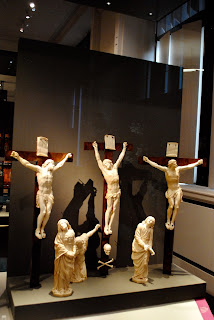Of course the museum is reason enough itself to go there, regardless of the weather.
I decided to check out the rooms called “Europe 1600-1815 Baroque”. This area covered the Baroque and Rococco eras. Each room had a theme. The first room focused on looking back to classic Greek and Roman art. The sculptor and architect Gianlorenzo Bernini created a fountain for the garden of Cardinal Montalto and called it “ Neptune and Triton” (1622-23). Here is the impressive piece.
Baroque designs focused on floral ornaments (flowers and fruit), mythological figures, emotion shown in faces and twisted columns. You see this everywhere.
Another room showed art that was a fusion of Mexican and European styles. This was due in part to the colonization by Spain of Mexico, South America and the Philippines. Much of this art had a religious theme.
Catholicism in art in the colonies and Europe was featured in one room. Here is an example of the crucifixion made in France (1664) of ivory.
Another room was called “Dutch Domesticity” and showcased dishes, wooden cupboards and household gadgets. In the following photo you will see a “curfew” to cover up embers to keep your fire warm overnight and a “warming pan” to pass through your bed sheets to heat them up at night before you go to bed. The description said “for women who haven’t got a man who can warm their feet for them “!
Global trade with Asia and the Americas was the next topic. Below is a coffer on a stand that was made in Japan for the European market and taste. It was made sometime between 1590 and 1625. It is made of wood with plates of shell and black/gold lacquer - all the rage in Europe at that time.
“The Cabinet” refers to either a private collector’s treasures or a storage cabinet. Both are found in this room. An example of the former is obvious with this glass virginal made between 1604 and 1620 in Austria or Germany. It is made of soft wood with decorations of silk and glass. It is able to be played.
An example of a decorative storage cabinet is seen in this Belgian cabinet depicting the story of the prodigal son. It was built between 1640 and 1660 of oak with ebony and oil painted panels. There are drawers to store your treasures.
The rise of France under King Louis XIV encouraged the promotion of the arts, as Louis was a big fan. He encouraged others to value the arts. The cabinet maker André-Charles Boulle, a friend of Louis, developed a technique of inlaying turtleshell, metals, bone, horn and ivory in wooden surfaces. The process is called “marquetry”. It is quite exquisite.
The Rococco period of art features curvy shapes such as scrolls in the shape of the letters “C” and “S”. The fad started in France and moved to Germany and Italy. Here is a writing cabinet made in Dresden between 1750 and 1755 for Augustus III, King of Poland.
This tile wall panel features musicians and dancers and was made in Portugal. It was meant for warm climates, as wall tapestries didn’t survive the heat and humidity well. It was made between 1720 and 1730.
After the Rococco room, neoclassicism was featured. A return to the Classical Greek and Roman styles with straight lines and restrained elegance was a welcome change in style.
I highly recommend a visit to this section of the museum. Next time I will try to find the rooms about Europe prior to 1600.








No comments:
Post a Comment